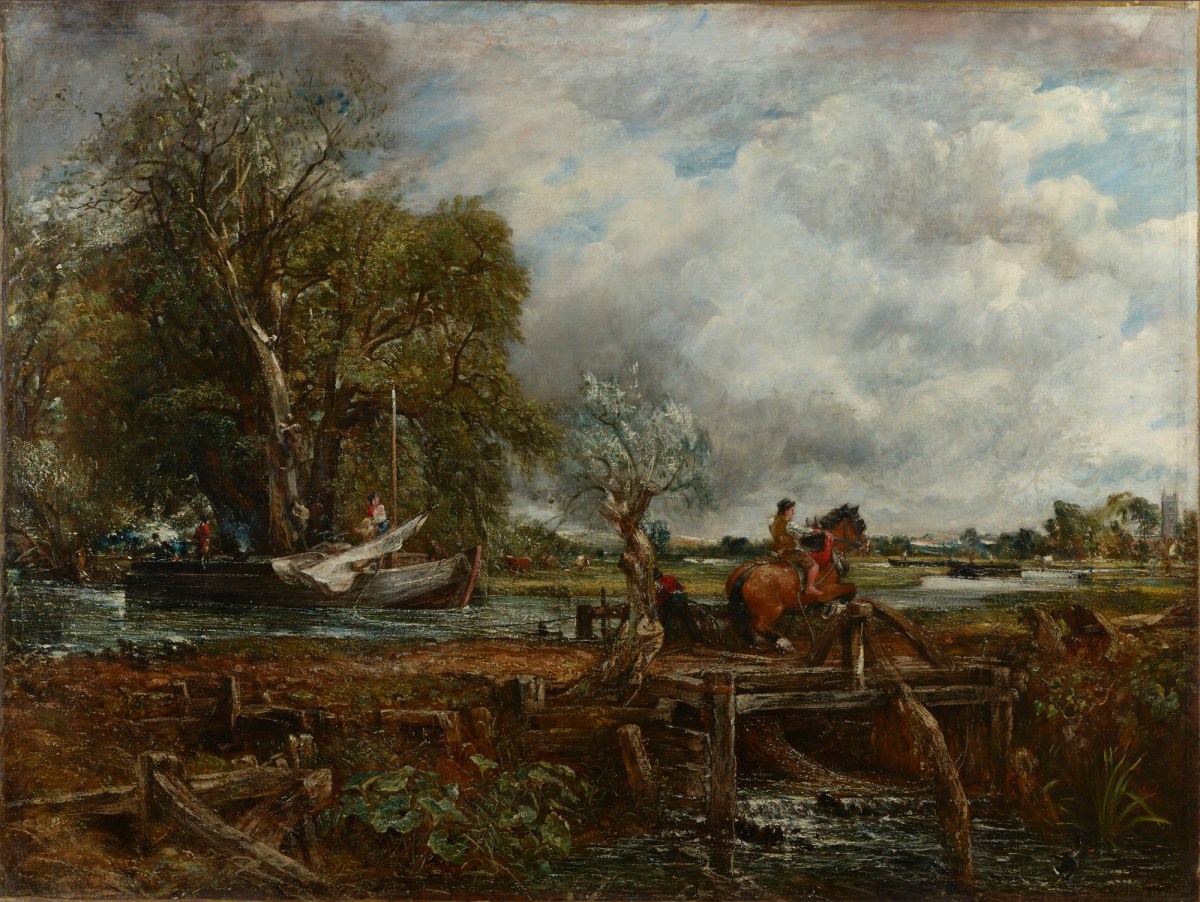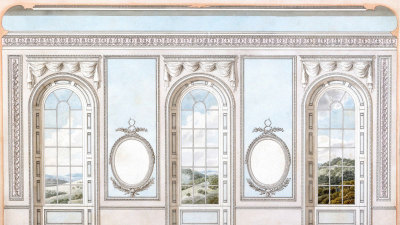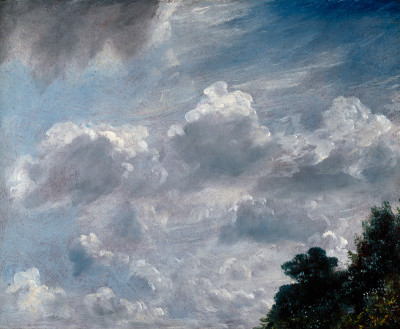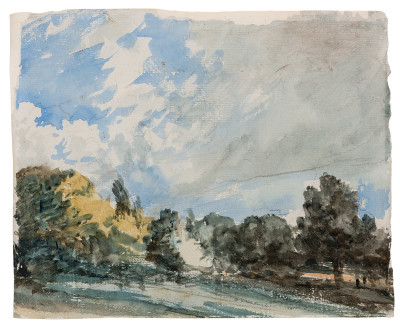
John Constable RA, The Leaping Horse, 1825.
Oil on canvas. 1420 mm x 1873 mm. © Photo: Royal Academy of Arts, London. Photographer: Prudence Cuming Associates Limited.
This image is not available to download. To licence this image for commercial purposes, contact our Picture Library at picturelibrary@royalacademy.org.uk
The Leaping Horse, 1825
John Constable RA (1776 - 1837)
RA Collection: Art
The barge lowers its sail, the rope slackens and the tow horse leaps the barrier on the path. John Constable depicts a scene in Suffolk where he spent his 'careless boyhood'. He claimed that the Suffolk countryside 'made him a painter'.
Constable paid great attention to weather and he described this painting as ‘a lovely subject, of the canal kind, lively – & soothing – calm and exhilarating, fresh – & blowing.’
In 1819 Constable embarked upon a series of large six-foot canvases with the aim of making his reputation as a serious landscape painter. The Leaping Horse is from this series and depicts a tow horse jumping one of the barriers erected along the path by the River Stour to prevent cattle from straying.
The painting was begun in 1824 and was exhibited at the Royal Academy in 1825 but remained unsold. Constable then altered the composition by painting over an old willow stump which was in front of the horse, although a faint trace of the tree can still be seen. The removal of the willow stump and the addition of the half-furled sail on the barge gave the composition greater strength and direction by concentrating the eye on the dramatic leap of the horse.
The Leaping Horse takes for its subject the traffic on the River Stour and the site has been identified as the Float Bridge or the Float Jump which includes the feature we can see here of the sluice on the south bank of the Stour on the Essex bank at a point where the course of the old river leaves the main branch of the river section. Over the sluice is the small wooden bridge and wooden barrier. It is over this barrier the horse jumps – local Suffolk barge horses were specially trained to jump over three-feet-high barriers erected along the tow-path in order to keep cattle from straying.
Local details are included with the elibray or eel trap which is the netting we see under the bridge set up to catch eels. Dedham Church at right of the picture was only revealed only fully during relining of the picture in 1952 and is not topographically accurate. The inclusion of the church as well as providing a finishing point on the right of the painting also places this work firmly in Suffolk. This bridge marks a county boundary – the horse is in fact leaping over a crossing which takes the horse and rider from Essex into his native Suffolk.
Constable began work on this picture in November 1824. He wrote to Fisher on 17 Nov telling him that he was planning a 'large picture' and by 17 Dec he was 'putting a 6-foot canvas in hand' (Beckett VI, pp.181, 187). An early study (British Museum 1888, 0215.72) of 1824 shows two barges manoeuvring past the Float Jump with a horse standing by the bridge. The next study (British Museum 1888, 0215.71) shows a single boat and the horse is now jumping the barrier but without a rider. The full size sketch in the V&A however shows a rider on the horse. It has been noted by Kenneth Clark that Constable 'must have recognised unconsciously that the horse on its high, architectural base was like an equestrian monument; and so in the final version this rustic episode takes its place at the end of that long line of heroic commanders on prancing horses which began with Leonardo da Vinci's monument to Francesco Sforza' (Looking at Pictures, 1960, p.120).
Constable reported on his progress with this painting to his friend Archbishop Fisher. In January 1825 he explained to Fisher that he was 'before a six foot canvas - which I have just launched with all my usual anxieties it is a canal scene'. However he then reported that he was making good progress and the subject was 'the large subject now on my Easil is most promising and if time allows [it] I shall far excell most of my other large pictures in it. it is Canal. and full of the Bustle of incident to such a scene where four or five boats are passing in Company with dogs. Horses boys & Men & Women & Childre. and best of all old timberprops, Water plants. Willow stumps. sedges old nets etc. etc. (Beckett VI, pp.190-1). And again In April he wrote to Fisher just after he had sent it to the RA exhibition and explained that 'no one picture ever departed from my Easil with more anxiety on my part with it' wrote (8 April 1825, Beckett VI, p.198).
In 1825 Constable also described the painting in a letter, as ‘a lovely subject, of the canal kind, lively – & soothing – calm and exhilarating, fresh – & blowing, but it should have been on my easil a few weeks longer.’ (Beckett VI, pp.197-8) The work was unsold from the exhibition and X-Rays of the finished picture show the various changed which Constable made once the picture was returned to him. They reveal that a boat entering from left, one of figures in main barge manoeuvring the boat with pole and a cow on the far river bank were later painted out of finished picture.
The main compositional difference with full sized sketch is the willow which is to right of horse but in final picture is on the left. This opens up the vista and allows the momentum of the horse's jump to be fully realised. Originally the willow was to the right in the finished picture and probably that is where it was when exhibited in 1825. In September when painting returned to him unsold Constable explained that he 'Got up early … Took out the old willow stump by my horse, which has improved the picture much … [and] made one or two other alterations.' (Beckett II, p.385). The willow tree is just visible still but this is probably because the paint has become more transparent over the years. The stump of willow tree remained.
Supported by The Thompson Family Charitable Trust
Related works:
John Constable's full scale sketch for The Leaping Horse, oil on canvas, 1294 x 1880 mm, Victoria and Albert Museum (object number 986-1900).
Further Reading
R.B. Beckett, John Constable's Correspondence Vol I, Ipswich, Suffolk, 1962
R.B. Beckett, John Constable's Correspondence II, Early Friends and Maria Bicknell (Mrs. Constable) Vol II, Ipswich, Suffolk, 1964
R.B. Beckett, John Constable's Correspondence III, The Correspondence with C.R. Leslie Vol III, Ipswich, Suffolk, 1965
R.B. Beckett, John Constable's Correspondence IV, Patrons, Dealers and Fellow Artists Vol IV, Ipswich, Suffolk, 1966
R.B. Beckett, John Constable's Correspondence V, Various Friends… Vol V, Ipswich, Suffolk, 1967
R.B. Beckett, John Constable's Correspondence VI, The Fishers Vol VI, Ipswich, Suffolk, 1968
Graham Reynolds, The Later Paintings and Drawings of John Constable, 1984
Leslie Parris & Ian Fleming-Williams, Constable, exh. cat., Tate, 1991
Anne Lyles, ed., Constable: The Great Landscapes, exh. cat., Tate 2006
Mark Evans, Constable: The Making of a Master, exh. cat., V&A, 2014
Object details
1420 mm x 1873 mm
Associated works of art
1 results
Start exploring the RA Collection
- Explore art works, paint-smeared palettes, scribbled letters and more...
- Artists and architects have run the RA for 250 years.
Our Collection is a record of them.




